ASRock Industrial NUC BOX-N97 and GMKtec NucBox G2 Review: Contrasting Compact ADL-N Options
by Ganesh T S on October 6, 2023 9:45 AM EST- Posted in
- Systems
- UCFF
- Mini-PC
- ASRock Industrial
- Alder Lake-N
- micro-PC
- GMKtec
System Performance: Miscellaneous Workloads
Standardized benchmarks such as UL's PCMark 10 and BAPCo's SYSmark take a holistic view of the system and process a wide range of workloads to arrive at a single score. Some systems are required to excel at specific tasks - so it is often helpful to see how a computer performs in specific scenarios such as rendering, transcoding, JavaScript execution (web browsing), etc. This section presents focused benchmark numbers for specific application scenarios.
3D Rendering - CINEBENCH R23
We use CINEBENCH R23 for 3D rendering evaluation. R23 provides two benchmark modes - single threaded and multi-threaded. Evaluation of different PC configurations in both supported modes provided us the following results.
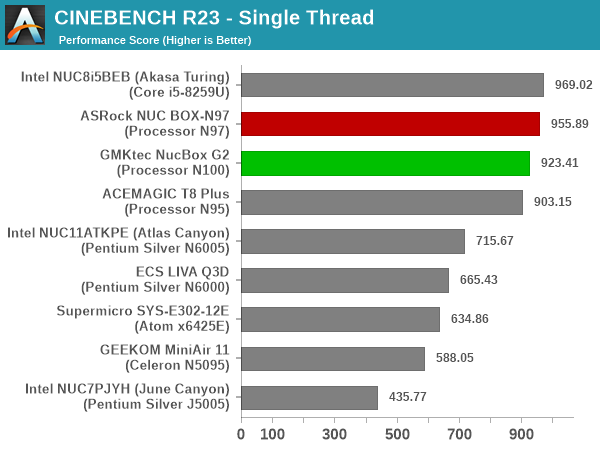

The 2W edge in the PL1 gives the NUC BOX-N97 the honors in the single-threaded rendering performance. However, with multiple threads in the picture, the systems are bunched together and the scores for all of them are within the realm of run-to-run variations.
Transcoding: Handbrake 1.5.1
Handbrake is one of the most user-friendly open source transcoding front-ends in the market. It allows users to opt for either software-based higher quality processing or hardware-based fast processing in their transcoding jobs. Our new test suite uses the 'Tears of Steel' 4K AVC video as input and transcodes it with a quality setting of 19 to create a 720p AVC stream and a 1080p HEVC stream.
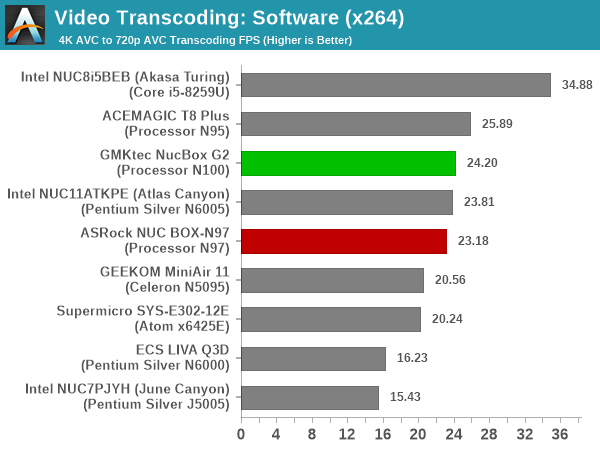
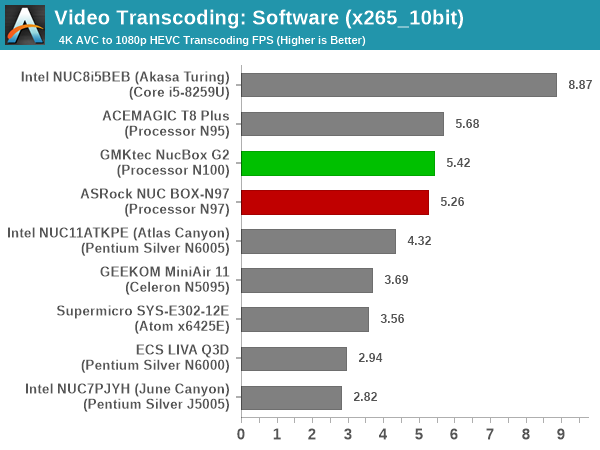
Software transcoding should ideally just be dependent on the number of cores and power limits. However, despite the 2W edge, the NUC BOX-N97 drops down a bit compared to both the NucBox G2 and the T8 Plus. The only reasonable explanation appears to the use of LPDDR5 in the latter two systems. The higher PL1 (15W) of the T8 Plus gives it the edge despite the slower LPDDR5 memory.
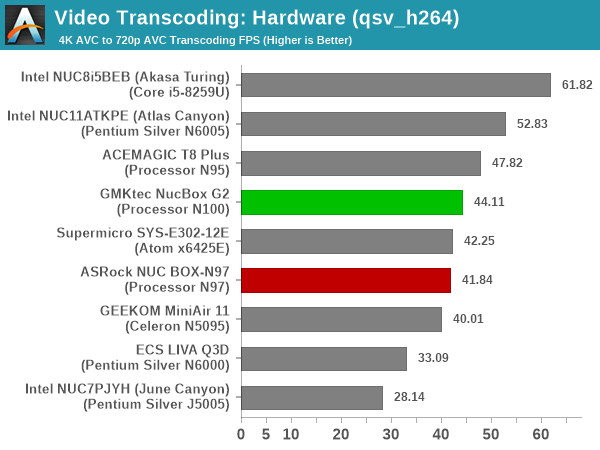
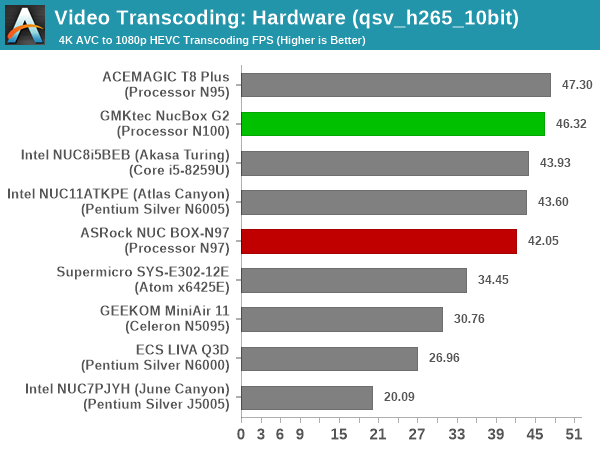
The 15W PL1 of the T8 Plus puts it above the NucBox G2 and the NUC BOX-N97, and between the latter two, the faster LPDDR5 memory seems to positively impact the G2.
Archiving: 7-Zip 21.7
The 7-Zip benchmark is carried over from our previous test suite with an update to the latest version of the open source compression / decompression software.
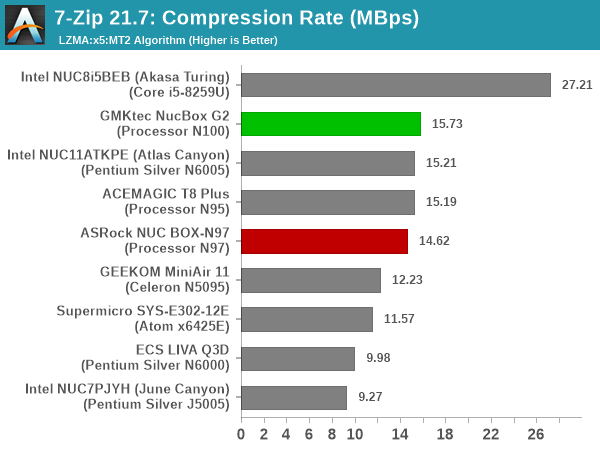
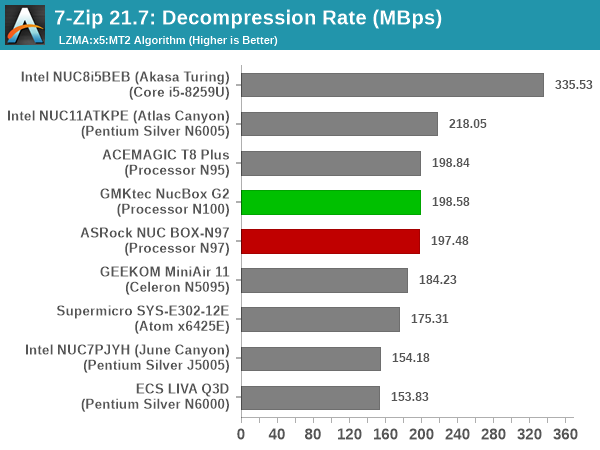
The numbers for the three ADL-N systems are close together. The edge seems to be with the NucBox G2, with its LPDDR5-4800 memory.
Web Browsing: JetStream, Speedometer, and Principled Technologies WebXPRT4
Web browser-based workloads have emerged as a major component of the typical home and business PC usage scenarios. For headless systems, many applications based on JavaScript are becoming relevant too. In order to evaluate systems for their JavaScript execution efficiency, we are carrying over the browser-focused benchmarks from the WebKit developers used in our notebook reviews. Hosted at BrowserBench, JetStream 2.0 benchmarks JavaScript and WebAssembly performance, while Speedometer measures web application responsiveness.
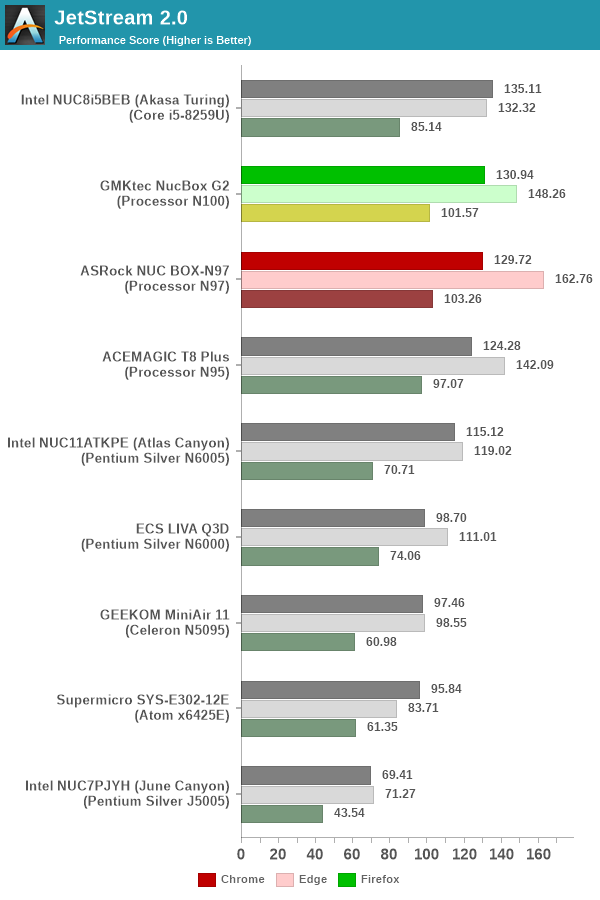
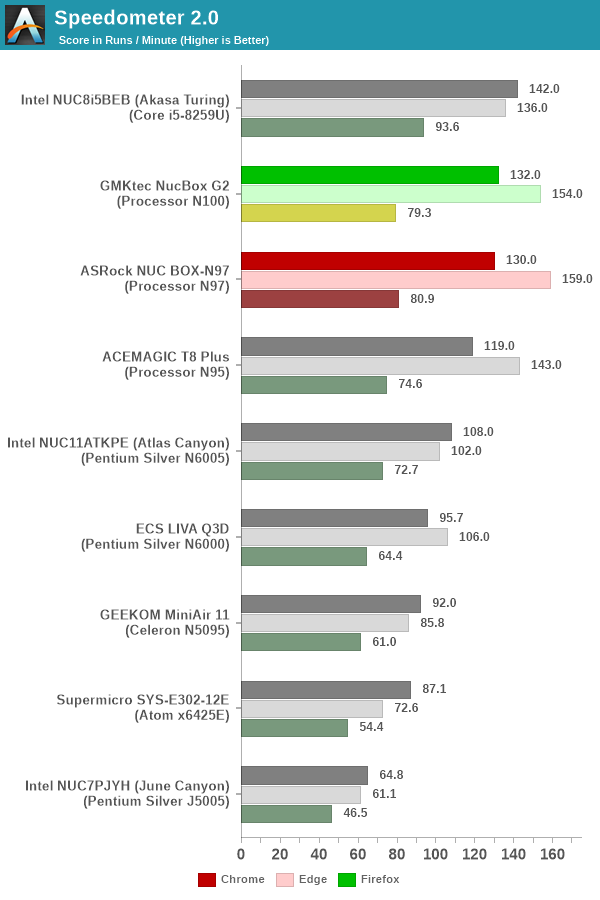
From a real-life workload perspective, we also process WebXPRT4 from Principled Technologies. WebXPRT4 benchmarks the performance of some popular JavaScript libraries that are widely used in websites.
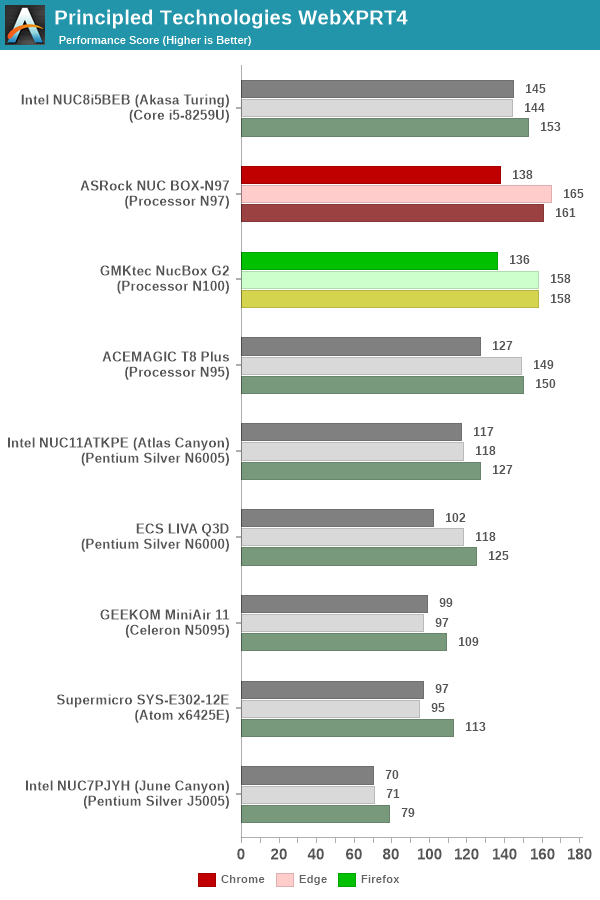
Single-threaded performance is important here, and the 2W PL1 edge gives the NUC BOX-N97 a leg up. This is particularly seen with the Edge browser. Overall, we find the scores largely tallying with each other across the same browsers.
Application Startup: GIMP 2.10.30
A new addition to our systems test suite is AppTimer - a benchmark that loads up a program and determines how long it takes for it to accept user inputs. We use GIMP 2.10.30 with a 50MB multi-layered xcf file as input. What we test here is the first run as well as the cached run - normally on the first time a user loads the GIMP package from a fresh install, the system has to configure a few dozen files that remain optimized on subsequent opening. For our test we delete those configured optimized files in order to force a ???fresh load??? every second time the software is run.
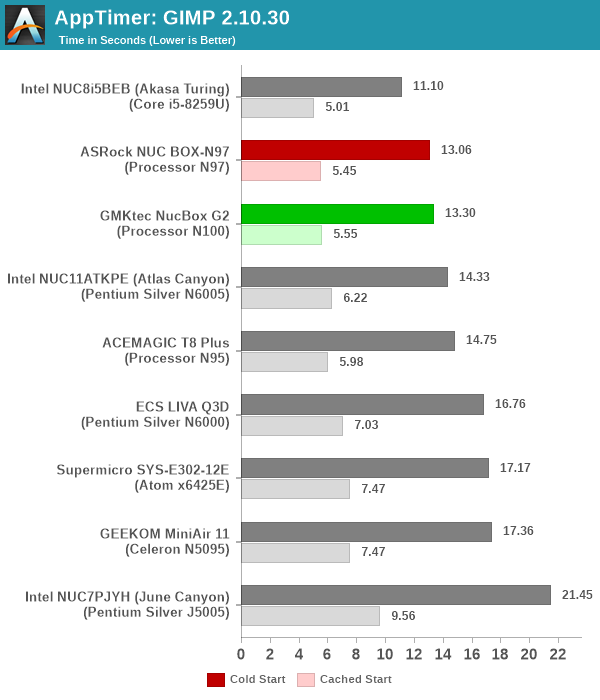
As it turns out, GIMP does optimizations for every CPU thread in the system, which requires that higher thread-count processors take a lot longer to run. So the test runs quick on systems with fewer threads, however fast cores are also needed. Both PL1 and PL2 settings help here, which is why the T8 Plus's 15W / 15W is not effective enough against the NUC BOX-N97's 12W / 25W and the NucBox G2's 10W / 25W. The 2W edge for the N97 is reflected in the above graph.
Cryptography Benchmarks
Cryptography has become an indispensable part of our interaction with computing systems. Almost all modern systems have some sort of hardware-acceleration for making cryptographic operations faster and more power efficient. In the case of IoT servers, many applications - including web server functionality and VPN - need cryptography acceleration.
BitLocker is a Windows features that encrypts entire disk volumes. While drives that offer encryption capabilities are dealt with using that feature, most legacy systems and external drives have to use the host system implementation. Windows has no direct benchmark for BitLocker. However, we cooked up a BitLocker operation sequence to determine the adeptness of the system at handling BitLocker operations. We start off with a 4.5GB RAM drive in which a 4GB VHD (virtual hard disk) is created. This VHD is then mounted, and BitLocker is enabled on the volume. Once the BitLocker encryption process gets done, BitLocker is disabled. This triggers a decryption process. The times taken to complete the encryption and decryption are recorded. This process is repeated 25 times, and the average of the last 20 iterations is graphed below.
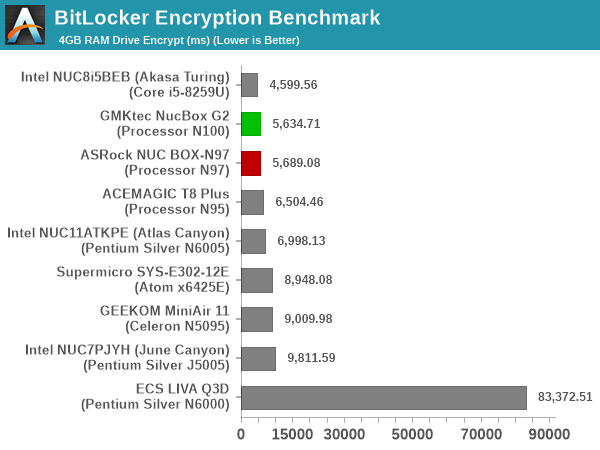
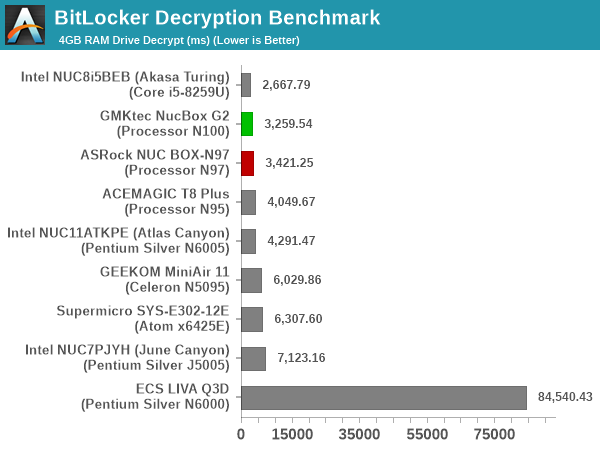
Hardware acceleration is available for the operations in all of the systems. The time taken for processing is directly dependent on the available power budget and the RAM speed, which gives the NucBox G2 a slight edge.










20 Comments
View All Comments
meacupla - Friday, October 6, 2023 - link
n100 vs n200, n200 is faster. That I can understandn100 vs n97, n97 is faster. Who came up with this naming scheme?
NextGen_Gamer - Friday, October 6, 2023 - link
Total agree, Intel had the opportunity with a new new series (Intel Processor N) and still messed it up. N50 is 2 cores, 6-Watts. N97, somehow, is 4 cores, at 12-Watts. Then you move "up" to N100, 4 cores, but at 6-Watts. N200 is the same as N100, but gets a small clockspeed bump and finally gets you the full Intel UHD Graphics @ 32 EUs. Then Intel went ahead and named the 8 core ones to Core i3 N300/N305 - why throw the i3 in there??? Why not just keep it as Intel Processor N300? At least the split between N300/N305 makes sense: N305 just gets a higher TDP, and nothing else.mode_13h - Sunday, October 8, 2023 - link
Lots of good points, here. However, the part about N97 can be partially explained in that I believe it's not one of their models meant for things like Chromebooks. Rather, it's more of a specialty/embedded part. If you look at them on ark.intel.com, the N97 lists its product segment as Embedded, while the N100's vertical segment is Mobile.The fact that they're aimed at different segments means their specs don't necessarily have to plot along the same continuum. Though, it'd be nice if they did.
NextGen_Gamer - Monday, October 9, 2023 - link
@ mode_13h - Ahh, you are right, that does explain it, a little at least haha. I am personally waiting for a nice NUC-type box to come around with the N200 in it, and *hopefully* a SO-DIMM for DDR5 and M.2 2280 for the SSD.mode_13h - Monday, October 9, 2023 - link
Beware of how many lanes are active on the SSD, though. PCIe 3.0 x1 is pretty disappointing, though it still beats SATA!I was expecting to see at least x2 - these SoCs don't have a ton of I/O, but they have one more lane than the previous generation. Going back 2 generations, Gemini Lake had only PCIe 2.0 x6! So, you'd really think they could spare at least 2 lanes for NVMe.
NextGen_Gamer - Tuesday, October 10, 2023 - link
I currently have the Intel NUC11ATKPE, with the Pentium Silver N6005 processor. My WD SN850 is running at PCIe 3.0 x2 right now, but I really don't see why these newer Alder Lake-N systems wouldn't want to spare a full PCIe 3.0 x4 for the M.2 slot. I would rather sacrifice other I/O and have your storage subsystem running as fast as it can.deil - Wednesday, October 11, 2023 - link
Well, its buldozer kind of thing.It's NEWER, with ddr5 instead of ddr4 AND $100 cheaper.
If your order them by price, performance matches.
sjkpublic@gmail.com - Friday, October 6, 2023 - link
Are the memory timing right? Seems like the ASROCK is a stronger box. Main diff is 2W of powerat idle? And $30 bucks?
ganeshts - Saturday, October 7, 2023 - link
Yes, memory timing is for LPDDR5-4800 (it is not comparable against DDR4-3200 timings or DDR5 timings).The ASRock box is substantially different from the G2 - check the I/Os and also more importantly it has scope for additional user configuration wrt RAM capacity and SSD capacity. The G2 has soldered RAM.
Btw, the difference in price is not $30, but more than $100. The G2 is ready out of the box for $230 with Win 11 Pro pre-installed. The NUC BOX-N97 needs RAM, SSD / HDD, and OS to be supplied by the user.
mode_13h - Sunday, October 8, 2023 - link
Also, the NUC BOX-N97 is from ASRock Industrial, and therefore presumably built to a higher standard and with better support!I've never heard of GMKtek - do they offer real support for US-based customers? What's the warranty on that unit? How long do you think they'll keep releasing BIOS updates for it?